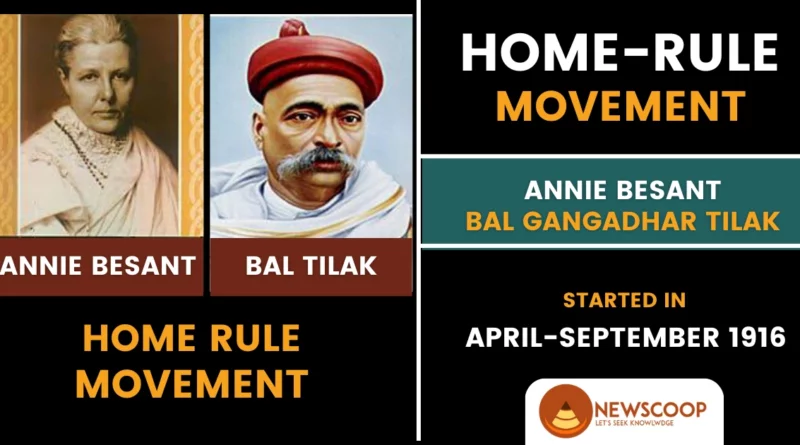Home Rule Movement: Objectives, Causes & Outcomes
India’s struggle for independence witnessed various movements and initiatives that played a crucial role in the country’s march towards freedom. One such significant movement was the Home Rule Movement, which emerged as a powerful force in the early 20th century. The Home Rule Movement, initiated by Annie Besant and Bal Gangadhar Tilak, aimed to establish self-government and autonomy within the British Empire.
This movement not only galvanized the Indian masses but also laid the foundation for future struggles against colonial rule. In this article, we will delve into the Home Rule Movement, its key features, its impact, and its relevance for aspirants preparing for the UPSC exam.
| Movement | Home Rule Movement |
| Time Period | 1916-1918 |
| Leaders | Annie Besant, Bal Gangadhar Tilak |
| Objective | Attainment of self-government (Home Rule) |
| Organizing Body | All India Home Rule League |
| Formation | Annie Besant founded the league in September 1916, and Tilak later started a parallel league in April 1916 |
What is the Home Rule Movement?
The Home Rule League was established in April and September 1916 by two prominent figures: Indian nationalist Bal Gangadhar Tilak and British social reformer Annie Besant. Inspired by the Irish Home Rule movement, the Home Rule League aimed to achieve self-government for India.
It sought to establish a system of self-governance, similar to the Irish model, as a means to gain independence from British rule. Further, the movement advocated for autonomy within the framework of the British Indian government, with the ultimate objective of achieving complete independence.
Foundation
The Home Rule League was launched by two prominent leaders, Annie Besant, and Bal Gangadhar Tilak, in different time periods and locations.
- Tilak’s Indian Home Rule League: April 1916 in Belgaum.
- Besant’s Home Rule League: September 1916 in Madras.
Both leagues aimed to achieve self-government in India. Tilak’s league operated in Maharashtra (except Bombay), Karnataka, Berar, and the Central Provinces, while Besant’s league worked in the rest of the country.
Headquarters of Home Rule League
- Tilak’s league had its headquarters in Delhi with six branches.
- Besant’s league had 200 branches but a less formal organizational structure.
Objectives of the Home Rule Movement
Here are the objectives of the Home Rule Movement:
- Attain self-government for India.
- Encourage political discourse and education to ignite self-government agitation.
- Empower Indians to voice their concerns against government repression.
- Advocate for increased political representation and influence for Indians.
- Revitalize Indian politics while upholding the ideals of the Congress Party.
Members of the Home Rule Movement
Important members of the Home Rule Movement include:
- Annie Besant
- Bal Gangadhar Tilak
- Muhammad Ali Jinnah
- Srinivasa Iyengar
- Joseph Baptista
Causes of the Home Rule Movement
- Disappointment with the Government of India Act of 1909.
- Congress Party split in 1907 and Bal Gangadhar Tilak’s imprisoned in 1908.
- Revival of the national movement after Tilak’s release from exile.
- Annie Besant’s support and influence in advocating for Indian causes.
- Efforts to rejoin the Indian National Congress by Tilak and other extremists.
- Establishment of separate Home Rule Leagues by Besant and Tilak.
- Limited Indian representation and dissatisfaction with British rule.
- Impact of World War I, providing an opportunity for Indians to assert their demands for self-rule.
- Rising national consciousness and awareness of shared identity.
- Inspiration from the successful Irish Home Rule movement.
- Economic exploitation and discrimination under British rule.
- Intellectual and cultural awakening during the Indian Renaissance.
Course of Movement
The course of the Home Rule Movement can be summarized as follows:
Formation of Home Rule Leagues: Annie Besant and Bal Gangadhar Tilak formed Home Rule Leagues across the country to mobilize people for the cause of self-rule and raise awareness about the benefits of self-governance.
Broad-based participation: The movement witnessed widespread participation from different sections of society, fostering a sense of unity among the people. It attracted members from various factions of the Indian National Congress and the Muslim League.
Montague Declaration of 1917: It played a significant role in influencing the Montague Declaration, also known as the August Declaration, in 1917. This declaration promised political reforms and increased participation of Indians in the governance of their country.
The precursor to India’s struggle for independence: Laid the foundation for India’s subsequent struggle for independence. It served as a catalyst and inspiration for future movements, including the Non-Cooperation Movement led by Mahatma Gandhi.
Overall, the Home Rule Movement played a pivotal role in mobilizing people, fostering unity, and setting the stage for India’s journey toward achieving self-rule and eventual independence.
Significance
The Home Rule Movement held great significance in India’s freedom struggle:
- The Home Rule Movement gained significant support, with a membership of around 40,000 in 1917.
- It fostered a strong sense of national unity and mobilized people from different regions and religions.
- The movement brought together moderates, extremists, and the Muslim League temporarily, promoting a spirit of cooperation.
- The leaders of the movement effectively inspired people to join the freedom struggle and spread awareness about self-governance and democratic values.
- In addition, this led to the Montague Declaration of 1917, which aimed to include more Indians in the government and establish self-governing institutions.
- Overall, the Home Rule Movement is regarded as a crucial milestone in Indian nationalism and paved the way for India’s eventual independence in 1947.
- It served as a precursor to subsequent movements like the Non-Cooperation Movement and the Civil Disobedience Movement, which played vital roles in India’s struggle for freedom.
Outcomes of the Home Rule Movement
| Outcomes of the Home Rule Movement | Description |
|---|---|
| Arrests and Popular Revolt | The government’s crackdown on the home rule league led to widespread rebellion, with even moderate politicians joining the movement. |
| Government of India Act 1919 Reforms | Administrative changes introduced under this act led to the establishment of self-governing institutions, paving the way for responsible governments in India. |
| Formation of Provincial and Central Govts | The Government of India Act 1919 resulted in the creation of provincial and central governments, addressing the demand for home rule. |
| Release of Annie Besant | Annie Besant’s release by the British government and her subsequent election as Congress President marked a significant milestone for the movement. |
| Unity within Congress | The movement brought together moderates and extremists within the Congress, overcoming divisions from the 1907 Surat session and strengthening the party’s national unity. |
| Shift in Congress’ Approach | The movement influenced Congress to adopt more assertive methods such as ‘demand’ and ‘agitation’ for self-rule, moving away from previous reliance on ‘petition’ and ‘prayer’. |
Also Read: Quit India Movement
Failure & Decline of Movement
The Home Rule Movement, which was initially vibrant and influential, experienced a decline for various reasons. Here are some of the factors that contributed to its dissolution:
- Differences in Approach: Tilak’s advocacy of passive resistance initially deterred moderate Congress workers, creating a division within the movement.
- Uncertainty Regarding Government Reforms: Annie Besant’s indecision regarding accepting or rejecting the government’s promised reforms created confusion and weakened the movement’s momentum.
- Lack of Leadership: Tilak’s extended absence due to his pursuit of a libel case in London left the Home Rule Movement without a strong leader, which impacted its effectiveness.
- Failure to Garner Broad Support: The leagues struggled to gain support from various communities, including Muslims, Anglo-Indians, and non-Brahmins, who believed that home rule would result in dominance by the upper-caste Hindu majority.
- Satisfaction with Government Assurances: Some moderates within the Congress Party were content with the government’s assurance of reforms in the Montagu Declaration, which diminished their enthusiasm for the Movement.
- Lack of Firm Leadership: Annie Besant’s own internal divisions and inability to provide decisive leadership to her followers further weakened the movement.
- Crumbling Unity: The absence of Tilak and Besant’s leadership, along with various challenges, led to a loss of cohesion and unity within the Home Rule Movement.
- Merger with Congress: With the emergence of Mahatma Gandhi as a leader, the Home Rule Movement eventually merged with the Indian National Congress, shifting the focus and direction of the national struggle for independence.
Conclusion
The Home Rule Movement in India played a significant role in the country’s struggle for independence. It was launched by Annie Besant and Bal Gangadhar Tilak with the objective of achieving self-government in India. The movement witnessed the formation of two home-rule leagues led by Tilak and Besant, respectively.
Although the movement faced challenges and eventually declined, it had a lasting impact on India’s freedom struggle. It inspired the adoption of more assertive methods within the Congress, leading to subsequent movements like the Non-Cooperation Movement and the Civil Disobedience Movement. The movement’s emphasis on self-governance and democratic values laid the foundation for India’s eventual independence in 1947.
Overall, the Home Rule Movement served as a catalyst for the national awakening and the fight against British colonial rule, leaving a significant imprint on the history of Indian nationalism.
Thank You!
When were the two home rule leagues launched and who were their respective leaders?
The Indian Home Rule League, led by Tilak, was launched in April 1916 at Belgaum, while the Home Rule League, led by Annie Besant, was launched in September 1916 at Madras.
What is the Objective of the Home Rule Movement?
The objective of the Home Rule Movement in India was to achieve self-government within the British Empire, mobilize public opinion, and advocate for political independence through constitutional means.
Related Links:

